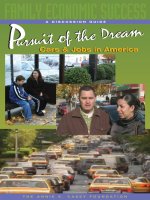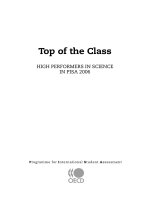A DISCUSSION GUIDE Pursuit of the Dream Cars & Jobs in America potx
Bạn đang xem bản rút gọn của tài liệu. Xem và tải ngay bản đầy đủ của tài liệu tại đây (472.35 KB, 24 trang )
A DISCUSSION GUIDE
FAMILY ECONOMIC SUCCESS
THE ANNIE E. CASEY FOUNDATION
PP
ursuit of the Dream
ursuit of the Dream
Cars & Jobs in America
Cars & Jobs in America
The Annie E. Casey Foundation is a private charitable
organization dedicated to helping build better futures for
disadvantaged children in the United States. It was established in
1948 by Jim Casey, one of the founders of UPS, and his siblings, who
named the Foundation in honor of their mother. The primary mission
of the Foundation is to foster public policies, human-service reforms,
and community supports that more effectively meet the needs of
today’s vulnerable children and families. In pursuit of this goal, the
Foundation makes grants that help states, cities, and neighborhoods
fashion more innovative, cost-effective responses to these needs.
The Casey Foundation believes that the children in greatest trouble
in America today are those whose parents lack the earnings, assets,
services, or social support systems required to consistently meet
their families’ needs. Most of these children are growing up in
impoverished communities that are disconnected from the economic
mainstream. The Foundation is working to help these isolated
families secure adequate incomes, stabilize their finances,
accumulate savings and assets, and live in vibrant, economically
viable neighborhoods through a combination of strategies known
as building family economic success, or FES. This documentary is
an educational tool and part of Casey’s FES approach to help
families connect with the mainstream economy.
For more information about the
Annie E. Casey Foundation or the
Family Economic Success initiative,
please visit: www.aecf.org
© 2008 The Annie E. Casey Foundation
PURSUIT OF THE DREAM: A DISCUSSION GUIDE
l
1
Pursuit of the Dream: Cars & Jobs in America, produced by the
Annie E. Casey Foundation, explains the importance of affordable, reliable
transportation for building the economic success of low-income families
and their communities. In order to attain self-sufficiency, stabilize their
finances, and move up the economic ladder, low-income workers must be
able to connect to good jobs and meet family obligations. A car is often
a necessity. However, common obstacles can make it difficult for low-
wage workers to improve their lives through car ownership.
Using three real-life stories, the documentary illustrates ways in which
common pitfalls prevent families from reaching better jobs, better oppor-
tunities, and a better quality of life.
■ Jesus works at two jobs to support his wife and children.
He attends school at night, trying to
improve his work prospects.
Public
bus transportation will not take him
to all the locations he must reach.
However, when he tries to buy a used
vehicle, he faces exorbitant interest
rates and large down payment
requirements for cars with high
mileage and questionable reliability.
Cars & Jobs in America
Cars & Jobs in America
A DISCUSSION GUIDE
About this Documentary
PP
ursuit of the Dream
ursuit of the Dream
2
l
PURSUIT OF THE DREAM: A DISCUSSION GUIDE
■ Tracy is a single mother who is working and also going to
school to earn a degree in criminal justice.
Years ago she had a bank loan for a
car that continually broke down and
required expensive repairs. Eventually
the car was repossessed. Her next car
was destroyed in an accident, leaving
her with a loan to pay off and no
transportation. Her credit was ruined
and she struggled to find a way to
get her life back on track.
■ Cindy is a single mother of two
sons who has overcome a history of
substance abuse, domestic abuse and
serious health problems.
Without a car,
her job options were limited to places she
could reach by walking or by bus. In one
job she had to walk three miles home
each night, in the dark, at 2 a.m. Cindy
wanted to enter an appr
enticeship
program to attain a meaningful job with
a promising future and health benefits, but she had no
transportation to reach the training site. A community car program
helped her to overcome this hurdle and her life was dramatically changed.
Following are some examples of common pitfalls low-wage workers
often face when purchasing a car and recommendations on how to avoid
them. This discussion guide also suggests ways to use this documentary
in your community and includes resources for more information.
The
Pursuit of the Dream: Cars & Jobs in America documentary is not
intended to be a comprehensive overview of the car ownership problem in
America but is a hands-on tool to help low-wage workers climb up the
economic ladder through knowledgeable car purchase and ownership.
PURSUIT OF THE DREAM: A DISCUSSION GUIDE
l
3
Car-Buying
Pitfalls and
Today, 88 percent of Americans drive their cars to work, with two-
thirds of new jobs located in suburban areas away from public transporta-
tion systems. A car can be a critical factor in getting and keeping a job
and moving up the career ladder toward financial independence.
Lack of access to a car creates serious difficulties for parents who juggle
work, errands, and transporting children to school, child care, and other
activities. Moreover, lower prices and a better selection of groceries, house-
hold items, and other services often are located in the suburbs.
Cars make commuting at night safer and decrease the vulnerability of
families during emergencies. Cars also are important for building other
assets: studies show that low-wage workers with cars are more likely to be
homeowners than those without one, perhaps because car owners have a
wider choice of locations for affordable, safe housing.
However, low-income people, who often have no bank accounts, poor
credit ratings, or no history of obtaining loans, can be taken advantage of
Tips
to Avoid Them
4
l
PURSUIT OF THE DREAM: A DISCUSSION GUIDE
when it come to purchasing a car. On average, low-wage workers pay
more than other households to purchase and maintain a comparable car.
There are a number of car-buying pitfalls that low-wage workers may face:
Pitfall #1: High-Interest Car Loans:
“Buy Here/Pay Here” Lots
At buy here/pay here car lots, it is the car dealer, not a finance company
that extends credit to the buyer. As highlighted in the documentary,
buy here/pay here lots often require high down payments and exorbi-
tantly high interest rates for their loans. At the lot Jesus visited, they
attempted to sell him a car with high mileage for a down payment that
would have actually covered the entire cost of the car. This means that
every payment made after the down payment would be clear profit for
the dealer. On top of that, the loan had a 30 percent interest rate.
If Jesus failed to meet the payments, the car would have been repos-
sessed, allowing the dealer to resell it to another buyer, starting the
cycle all over, and enabling the dealer to make his profit again on the
same vehicle.
There are about eight to 16 million people with low
and moderate incomes and poor credit who earn
below $40,000 a year who are subjected to the sub
prime lending market. The Federal Reserve reports
that those earning $30,000 or less per year, such
as Jesus, paid an annual interest rate that was 56.1
percent higher than people earning $90,000 a year.
In addition, most buy here/pay here lots do not
report payment history to the credit reporting
agencies, which prevents consumers from strength-
ening their credit history through steady repayment
of their car loan.
PURSUIT OF THE DREAM: A DISCUSSION GUIDE
l
5
Tip #1: Don’t Get a Loan from a Buy Here/Pay
Here Lot; Avoid Sub Prime (High-Interest)
Loans; Build a Relationship with a Local
Bank or Credit Union
Low-wage workers often don’t have checking or savings accounts or
bank-issued credit cards due to fear or uncertainty about how banks
or credit unions work. It is important for people to establish banking or
credit union accounts to facilitate savings, help build credit, and provide
a trusted and r
eliable resource to turn to when applying for a car loan.
As the banker said in the
video, “I do think that
there’s fear and shame
that gets in the way of
people walking into a
bank. I’d like people to
know that bankers…
we’re not anybody dif
fer-
ent than anybody on the
street. I’m a small-town
kid with a self-employed dad who had an eighth grade education…
most bankers want to connect with their community.”
Pitfall #2: Poor or No Credit History
Low-wage workers often hit a stumbling block when trying to buy a car
due to poor credit or no credit history. While there is a perception that
low-income workers have poor credit, a significant number simply have
no credit history.
Credit scores rate each individual’s creditworthiness on a numerical scale
from about 300 to about 850. The factors that influence a credit score
include payment history, the amount of money owed, the length of
6
l
PURSUIT OF THE DREAM: A DISCUSSION GUIDE
credit history, the types of credit,
and the amount of new credit
received. When individuals
don’t have credit cards or bank
accounts or own their own
home, it is difficult to obtain a
loan due to their lack of credit
history.
Tip #2: Car Ownership Programs
Buying a car from a traditional lot and getting a bank loan aren’t always
the only options. There are a number of programs, such as Vehicles
for Change in Baltimore, MD, and Working Wheels in Seattle, WA,
both highlighted in the documentary; and Ways to Work, with offices
across the country, that help low-income workers achieve the goal of
car ownership.
Given Tracy’s credit history, she felt that car ownership was impossible.
Once she heard about Vehicles for Change, however, she was able to
purchase a reliable used car that carried certain guarantees and receive
a low-interest loan to help rebuild her credit.
“This car right here probably would have been about $2,000 or more if
I had went to a car dealer. [Vehicles for Change] gave me the true value,
the book value, of this car,” Tracy said.
Pitfall #3: Being Pressured into a Bad Deal
Buying a car can be an intimidating experience for anyone, but especially
for someone who has never done it before, has little credit history, or
has language barriers. Used car lots are infamous for pushing buyers
into a deal, even if they’re not ready.
PURSUIT OF THE DREAM: A DISCUSSION GUIDE
l
7
For people like Cindy, who have struggled with no credit, illness, and
challenging life situations, a car can make the difference between
creating a better life and being stuck in a bad situation.
As Cindy said in the documentary, “That car did it for me. The car was
the final piece of the puzzle that I needed to complete my goals, which
was getting into the apprenticeship and getting a better job and sup-
porting my kids. I went to school, tried out for the Iron Workers and
was accepted and…just went from there. But I couldn’t have done
any of that without the car.”
Regardless of how desperately a car is needed, however, it’s vital to
do research ahead of time and be well prepared before beginning the
purchase process. Buyers should never impulse shop when it comes
to buying a vehicle.
Tip #3:: Take Your Time: Research and Education
It is important that low-wage workers take their time when buying a
car and make sure that they can afford the payments and maintenance.
Remember:
■
Avoid buy here/pay here dealerships and stay away from dealer
financing.
■
Don’t purchase a car on the first visit to a car dealership.
■
Understand “blue book” values (see Resources) and know what
the car is worth.
■
Negotiate on the purchase price of the car and nothing else.
Do not take a car to be traded, as that complicates the deal and
allows more room for dealer profit-building. Handle a trade sepa-
rately, after the car purchase is finalized.
■
Never negotiate on a “what you can afford to pay per month”
basis.
■
Insist on having the car inspected by a responsible and trustworthy
mechanic before purchasing.
8
l
PURSUIT OF THE DREAM: A DISCUSSION GUIDE
■
Stay away from car lots that won’t disclose the full purchase price
and instead only talk about a monthly payment plan.
■
Look into car programs that exist to help low-wage workers, such
as Vehicles for Change, mentioned earlier, or Working Wheels,
which helped Cindy to buy a car.
■
Open a bank or credit union account.
■
Know your credit score. If possible, work to repair your score
before buying a car. (See Resources for information on credit
scores, credit reports, credit repair.)
Most importantly, take your time when buying a car and stop the trans-
action if you feel pressured or confused.
Spread the Word
How to use this DVD
Pursuit of the Dream: Cars & Jobs in America is designed to be a
helpful tool for a variety of audiences, including policymakers, community
leaders, service providers, and low-wage workers. The DVD can be shown
at a community event; at a local, state, or federal policymakers’ forum; or
at seminars and workshops. It also may be shown to low-wage workers at
local car ownership or financial literacy programs. The goal of
Pursuit of
the Dream: Cars & Jobs in America
is to contribute to the dialogue about
car purchase and ownership issues.
Following the documentary screening, a group leader is encouraged to
guide a discussion about the issues highlighted in the stories and provide
handouts listing local resources and programs that offer car ownership
assistance, low-interest loans, and practical help with financial and credit
issues. Discussion questions and resources for materials that can be
included in participant handouts are included at the end of this guide.
PURSUIT OF THE DREAM: A DISCUSSION GUIDE
l
9
Audiences for This Documentary
Local, State and Federal Policymakers
Elected or appointed officials who represent low-wage workers and
families—or have business owners in their district who employ low-
income workers—should view the documentary to gain insight into
the challenges their constituents face around transportation issues.
HOW THEY CAN HELP:
There are a number of legislative steps policymakers can take to
support and improve transportation options, including:
■
Improve the quality and frequency of service on heavily traveled
inner-city bus and subway routes. This would better meet the
needs of transit-dependent low-wage workers than increasing
reverse-commute (commuting from city to suburb) options.
■
Implement policies recognizing the cost of commuting, one of
the only work-related expenses that receives no tax benefits in
the U.S., as a tax on earned income and implement tax policy to
alleviate those expenses.
■
Encourage public investment in support for nonprofit car programs.
Federal proposals for a pilot initiative like the Creating Access to
Rides (CAR) Act are worthy of consideration, as is encouraging use
of funding from the Job Access and Reverse Commute block grants
for local car programs.
■
Examine not only policy options that stimulate alternative markets
for car buyers, but also those options that would reduce fraud,
unfair practices, hidden excessive costs for the vehicle, and the high
cost of credit for all car buyers. For example, some states and even
municipalities have considered or implemented:
10
l
PURSUIT OF THE DREAM: A DISCUSSION GUIDE
• Caps on interest rates: Some states have usury laws or other
consumer finance laws that limit the interest rate that may be
charged to finance used cars.
•
Caps on dealer markups: In most low-income car purchase
transactions, the dealer arranges the financing in addition to
selling the car. Dealers typically contact prospective lenders and
present the consumer’s financial information. Lenders then will
inform the dealer on what terms they will be willing to lend to
that consumer. Often dealers will have consumers enter into
financing arrangements at a higher interest rate than the con-
sumer actually qualifies for. The dealer keeps most of the extra
money that will be paid by the consumer due to the higher
interest charges. Consequently the dealer has no inclination to
find a low interest rate for the consumer, but rather an incentive
to find financing that provides the dealer with the largest pay-
ment for putting the consumer in a more expensive loan. Some
states have imposed limits on how much the interest rate may
be increased above the rate for which the consumer actually
qualifies.
•
Limitations on “AS IS” sales of used cars: Low-income
consumers need a reliable car for transportation. Unfortunately,
consumers are often sold vehicles with known defects that are
hidden from the purchaser. While most states have lemon laws
that protect the purchaser of a new car, few states have effective
used car warranty laws. In most states dealers will commonly sell
used cars “AS IS” in order to disclaim the implied warranties that
otherwise apply. Some states have used car lemon laws or limit
disclaimer of warranties in used car transactions. Also some
states require that used cars be inspected not just for safety, but
also to make sure the vehicle is in adequate condition for high-
way travel.
PURSUIT OF THE DREAM: A DISCUSSION GUIDE
l
11
• Yo-yo car sales: “Yo-yo” car sales, commonly referred to by
dealers as “conditional delivery” or “spot delivery,” have a
devastating impact on low-income consumers. When a con-
sumer drives away from a dealer’s lot in a newly purchased car,
she typically believes herself to be the new owner and under-
stands that the deal is done. Certainly if a problem or defect
develops, the dealer will tell the consumer, “you bought it, it’s
yours.” However, the sales documents often purport to make
the transaction contingent on the dealer finding a lender willing
to finance the sale. All too often the unsuspecting consumer
will be called back into the dealer’s office and told that no lender
could be found on the terms the dealer gave to the consumer.
Often the dealer is simply bringing the customer back to get an
even higher interest rate or add more profitable items to the
sale. In such circumstances the consumer often believes there is
no choice but to accept the new terms presented by the dealer.
While such practices may violate state unfair and deceptive
practices laws or federal laws such as the Truth in Lending Act,
sometimes dealers structure these transactions to deprive
consumers of any recourse. Possible policy solutions range from
clarifying the moment the sale is consummated, allowing both
the buyer and the seller equal time to rescind the contract, or
prohibiting the dealer’s acceptance of any trade-in or down
payment until financing is finalized.
•
Pricing requirements and limits for extra products and
fees:
Many attempts to make the car market fairer have focused
on informing consumers about the interest rate they are agreeing
to pay and the price of the car. Facing such limitations, dealers
may look to other charges that are extremely profitable and often
pass unnoticed by the consumer. Products and services such as
window etching, rustproofing, or undercoating are often added
to purchase contracts and go unnoticed by the buyer. Dealers
have also increasingly relied on “document preparation” fees
12
l
PURSUIT OF THE DREAM: A DISCUSSION GUIDE
and other charges. Consumers often mistakenly believe that
these fees are some sort of government-imposed charges related
to title transfer or other regulated charges. In reality these fees
and charges are almost pure profit for the dealer and have
increased dramatically in recent years. Policy options for limiting
such abuses include absolute limits on the prices of such fees
and products, or requiring that such fees and products be
negotiated and paid for separate from the sale and financing
of the car itself.
•
Repossession issues: If a consumer is unable to make a pay-
ment on time or comply with other financing requirements, the
car will typically be repossessed without any court supervision,
and unless the consumer can pay everything due under the loan,
the car will be resold. Often the consumer will not only lose the
vehicle, but also be responsible for the rest of the loan balance
and often excessive costs and fees, less what the car is sold for
after repossession. Such repossessed cars are often sold far below
their market value, leaving the consumer liable for a large debt
and unable to purchase another car. In some states the consumer
has a right to pay the missed payment, also known as a “right
to cure,” and avoid repossession. Some states also permit the
consumer to pay the missed payments even after repossession,
often known as a “right to reinstate.” Another policy option is
to require that a procedure be followed before a vehicle may be
repossessed to ensure that the consumer is treated fairly and that
the lender really has a right to take possession of the car.
The National Consumer Law Center, with support from the Casey
Foundation, is developing a policy guide for advocates interested in
pursuing policy improvements. The guide will be available in the fall
of 2008 on the National Consumer Law Center’s website:
www.nclc.org/
PURSUIT OF THE DREAM: A DISCUSSION GUIDE
l
13
Community Leaders and Service Providers
People who work with or advise low-wage workers and families in
community-based agencies or institutions, such as social service agen-
cies, faith-based institutions, nonprofit organizations, and financial
institutions, as well as teachers, counselors, community development
practitioners, and others should make viewing and sharing this video
a priority.
HOW THEY CAN HELP:
Community leaders can play an important role in improving access to
affordable, reliable transportation options to strengthen the economy
and family well-being in a number of ways, including:
■
Connect with the 150+ nonprofits around the country that are
dedicated to increasing affordable, reliable, private automobile
ownership for low-wage workers. Explore how your organization
and community can support these initiatives.
■
Know what nonprofit car provider organizations exist in your
community, help to spread the word, and support the expansion
of their work. While insurance companies and car dealers charge
high rates to low-wage workers, nonprofit car providers are leading
the way in changing the marketplace to reduce the impact of
unfair business practices. These providers also help families
improve their credit ratings and develop banking relationships.
■
Pursue action steps to improve community and public transporta-
tion, including increasing options for bus service in dense urban
areas where there are still many residents and jobs.
■
Know what credit unions exist in your region and how they can
help low-income workers (see Resources).
14
l
PURSUIT OF THE DREAM: A DISCUSSION GUIDE
Low-Wage Workers and Their Employers
It is crucial for low-wage workers—and helpful for their employers—
to know the options that exist when buying a car.
HOW THEY CAN HELP:
Employers and others can help educate their employees by using this
DVD in a number of ways, including:
■
Show the documentary to incoming employees as part of their
orientation or during special training sessions.
■
Host a community forum and invite low-wage workers throughout
the community to watch the video and discuss it afterward.
■
Have the documentary shown at a workforce development center’s
worker meetings or make it available for viewing in a waiting area.
DISCUSSION QUESTIONS
1. Were you aware of these car
purchase or car ownership issues
before viewing the video?
2. What type of car financing is
currently available and prevalent in
your community?
3. What programs are available in
your area to assist people with car purchase and financing?
4. What educational programs (both for general financial matters and car
purchases) are available in your community?
5. What economic problems do buy here/pay here lots create in your
community?
6. Do you understand what credit scores are and their impact on car buying?
7. What do you consider to be a “reasonable” interest rate?
8. What economic and/or community issues could arise as a result of low-
wage workers not having access to reliable transportation?
9. Which local policies or potential
legislation for your community could
address these issues?
10. Who are the stakeholders for
improving transportation in your
community?
11. What are possible next steps to
take in your community?
PURSUIT OF THE DREAM: A DISCUSSION GUIDE
l
15
16
l
PURSUIT OF THE DREAM: A DISCUSSION GUIDE
RESOURCES
1. OPPORTUNITY CARS
Opportunity Cars is a network of more than 150 nonprofit organiza-
tions, such as Vehicles for Change, Working Wheels, and Ways to Work,
that are dedicated to increasing private automobile ownership for low-
wage working families to support their ability to find and retain quality
employment. Cars’ programs promote economic well-being and job
security by distributing cars directly to families, making low-interest
loans for car purchases, and facilitating matched savings for car down
payments and purchases.
Their website provides a list of vehicle ownership assistance programs
and car donation programs that offer full tax deductions. In addition,
it offers a search function by city, zip code, and state to identify local
initiatives across the country.
www.opportunitycars.com
2. AMERICANS FOR FAIRNESS IN LENDING
Americans for Fairness in Lending (AFFIL) raises awareness of abusive
credit and lending practices, especially in vehicle financing, and publishes
many resources on its website, including guides to loan types and car
financing guides.
www.affil.org/consumer_rsc/car_finance.php
3. CREDIT UNION LOCATOR
This important website helps consumers locate a credit union near them
and includes information about programs and membership r
equirements.
www.creditunion.coop/cu_locator/quickfind.html
4. NATIONAL CREDIT UNION FOUNDATION (NCUF)
The NCUF operates a program called REAL Solutions (Relevant, Effective,
Asset-building, Loyalty-producing Solutions) which provides technical
assistance to help state credit union leagues better serve low-income
working families. NCUF is identifying best practices and models in
PURSUIT OF THE DREAM: A DISCUSSION GUIDE
l
17
affordable auto lending and integrating these models into the REAL
Solutions program.
www.ncuf.coop/home/programs/realsolutions/realsolutions.aspx
5. INCLUSION
The Mobility Agenda at the Inclusion website provides a clearinghouse
of transportation policy briefs, news articles, and other resources.
www.inclusionist.org/transportation
6. CONSUMER REPORTS GUIDE TO BUYING A CAR
www.consumerreports.org/cro/cars/pricing/index.htm
The following list of websites, which comes from Consumer Reports,
provides helpful information about purchasing pre-owned vehicles,
securing loans and loan rates, and purchasing car insurance.
• Guide to Certified Pre-Owned Vehicles:
www.consumerreports.org/cro/cars/buyingleasing/consumer-
reports-certified-preowned-vehicles-1205/index.htm
• Keys to Getting the Best Loan Rate:
www.consumerreports.org/cro/cars/guide-to-new-car-buying/
financing/keys-to-the-best-loan-rate/index.htm
• All about Car Insurance:
www.consumerreports.org/cro/cars/suvs/car-insurance-a-quick-
guide-405/overview/index.htm
7. PUBLIC CITIZEN
Public Citizen is a national, nonprofit consumer advocacy organization
founded in 1971 to represent consumer interests in Congress, the exec-
utive branch and the courts.
www.citizen.org
Public Citizen has published a variety of reports on car ownership,
including:
• Rip Off Nation: Auto Dealers’ Swindling of America:
A comprehensive report for consumers on purchasing a car
www.citizen.org/documents/Rip-Off_report_only.pdf
• Auto Purchasers’ Top Five Defenses Against Yo-yo Financing Cons
and Other Dealer Scams: Consumer tips for car purchases
www.citizen.org/documents/Consumer%20Tips%20on%20Auto%
20Purchases.pdf
8. GUIDES TO CAR PRICES AND VALUES
Kelley Blue Book www.kbb.com
Edmunds.com www.edmunds.com
9. INFORMATION ABOUT CREDIT SCORES, CREDIT REPORTS, CREDIT REPAIR
Consumer Federation of America
www.consumerfed.org/pdfs/yourcreditscore.pdf
National Consumer Law Center
www.nclc.org/issues/seniors_initiative/content/creditrepair.pdf
18
l
PURSUIT OF THE DREAM: A DISCUSSION GUIDE
PURSUIT OF THE DREAM: A DISCUSSION GUIDE
l
19
REFERENCES
Annie E. Casey Foundation. Pursuit of the Dream: Jobs & Cars in America.
Documentary DVD, 2008.
Blumenberg, Evelyn. “Beyond the Spatial Mismatch: Welfare Recipients
and Transportation Policy.”
Journal of Planning Literature. Vol. 19, No. 2,
182-205. 2004.
Blumenberg, Evelyn and Margy Waller. “The Long Journey to Work: A
Federal Transportation Policy for Working Families.”
Brookings Center on
Urban and Metropolitan Policies, Transportation Reform Series.
July 2003.
Waller, Margy. “Auto-Mobility.” Washington Monthly. October/November
2005.
Waller, Margy. “High Cost or High Opportunity Cost? Transportation and
Family Economic Success.”
Brookings Institution Policy Brief. Center on
Children and Families. December 2005.
WRITING, EDITING and PROJECT MANAGEMENT
The Hatcher Group
DOCUMENTARY PRODUCTION
N.A.K. Production Associates
DESIGN
Elizabeth DiPalma Design
PRINTING
Friend Printing
Baltimore, Maryland 21202
410-547-6600
www.aecf.org









